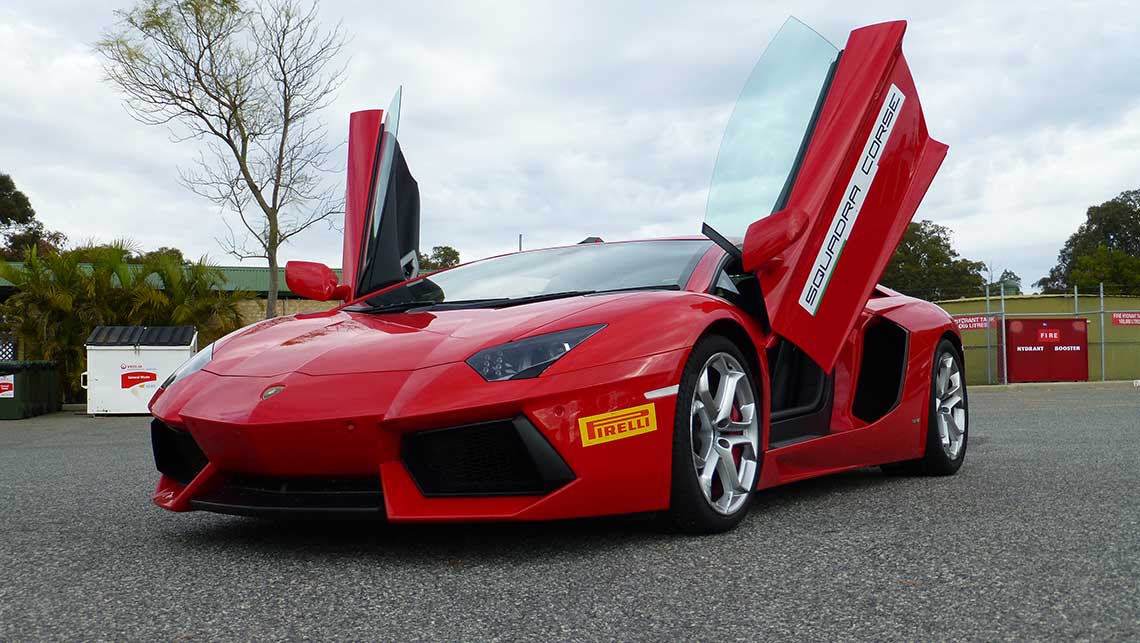
Lamborghini Aventador 2014 Overview
On the wall of a child's bedroom, a faded Lamborghini Countach poster once teased its viewer with a desire for wealth. It was an inaccessible car that personified success, strength, beauty, and for its driver, a certain element of courage.
As beautiful as the Countach is, the details are disappointing. Interior trim is sparse and deteriorates quickly, driver ergonomics leave a lot to be desired, chassis pipes are littered with ugly welding spatter, and excess paint lurks in the corners.
If it weren't for that V12 engine, that low-flat and impossibly wide wedge-shaped body and the engine's eruption at startup, it could have been an Italian Edsel. A quarter century later, at the V8 Supercars track in Perth, Lamborghini invites you to spend the day with the successor to the Countach.
I don't know if Aventador posters are available for 2014 bedroom walls, and I'm guessing time has blunted the radical Lamborghini styling formula pioneered by the Countach.
But it's still an undeniably exciting design. The Aventador LP700-4, now three years old and replacing the Murcielago and before that the Diablo and then the Countach, sits at the top of Audi's Lamborghini stable.
Below is the smaller Huracan (replacing the Gallardo) which will arrive in Australia next month.
DRIVING
I have a Lamborghini rep as a passenger, but he's as busy as can be because other than that one red LP700-4, the Wanneroo track is empty. Lift the red cover of the engine start button. Make sure the automatic manual transmission is in neutral by pulling back on both shift paddles, long batwing-shaped pieces of alloy mounted just behind the steering wheel.
Firmly press the brake pedal and press the starter. I'm ready for the noise. Basically it's an exhaust hum, strong enough to hide any mechanical thump from the V12 engine that's right behind the two seats.
Pull the right stalk back and the digital instrument panel will confirm first gear. There's a bump when the gearbox meets the engine, and a jerk when pressure on the accelerator causes the coupe to leave the parking lot.
It is so wide that it is exacerbated by poor visibility. Front and side acceptable. At the rear, it's a matter of scanning the two side mirrors. It would be impossible for the Aventador to parallel park.
The seat is narrow, firm and designed almost entirely to keep your body still while cornering. “I have two upshifts,” the right-hander noted, and the little steering wheel just nudged to set the car up. It discards the corner so the next one lines up faster it ignores and so subsequent turns are faster and easier to master.
A few more laps and I'm only using three gears, mostly only third, and fifth for downhill at 240 km/h and above. Apply the brakes and immediately feel the weight you are carrying towards the turn. Doubt crushes my thoughts. Can I slow this thing down to make a smooth right angle turn?
Under the brakes, with a heavy foot and a fluttering heartbeat, the carbon discs are compressed by 20 tiny brake pistons, sucking the coupe into the asphalt without a giggle. Down two gears, first around the corner under the rear accelerator, then instantly back on the volume pedal and ready for fourth, then fifth, before the next turn repeats the process of euphoria, anxiety, doubt and relief.
Gear changes take just 50 milliseconds - almost as fast as in a Formula 120 car - and, in perspective, compare with XNUMX milliseconds of the company's own Gallardo.
The V12, a complete departure from Lamborghini's previous 12-cylinder engine dating back to the 350 1964GT, seems like its power reserve is limitless. Its flow is so strong that I get to the point where I start to feel a little scared. It is similar to how this animal stretches the tether to the limit.
Despite an astounding 515 kW/690 Nm of power and a menacing 0 km/h time of just 100 seconds, the car is surprisingly forgiving and incredibly stable. Even though the power reaches a whopping 2.9 rpm.
Its handling is partly due to the all-wheel drive system, which hydraulically transfers power from the front wheels to the rear wheels, sensing changing road and traction conditions. It's also because it's a wide, flat car. Like a hockey puck on ice, it sticks to the surface and never feels like it will ever let go.
Yes, sure. During last year's test on the same track with other Lamborghinis, one of them suddenly flew off the track and pirouetted in the grass. Cold tires, a nervous driver and untimely pressing the accelerator pedal were to blame. It can happen so easily.
The steering is firm but street-friendly. Although the seven-speed robotic "automatic" is built for the track or fast European roads, it still works at lower speeds, despite some unpleasant bumps between shifts.

